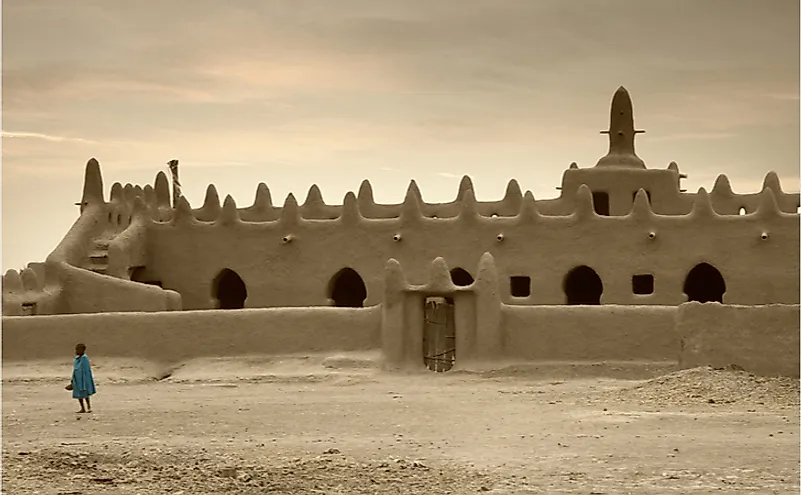10 interesting Facts About Mali

Mali is a landlocked country in West Africa that is surrounded by Senegal, Mauritania, Guinea, Ivory Coast, Niger, Burkina Faso, and Algeria. It occupies an area of about 480,000 sq mi, ranking as the eighth most extensive country in Africa and the twenty-third most extensive in the world. Mali is a sovereign state that is subdivided into 10 regions, and its economy is driven by mining and agriculture. Some of the country's primary natural resources are salt and gold, and Mali ranks as the third-largest gold producer in Africa. A series of interesting facts about Mali are listed below.
Mali Was Part of the Three West-African Empire That Controlled the Trans-Saharan Trade
Present-day Mali was part of the three West African empires that controlled the trans-Saharan trade of slaves, salt, and gold, among other commodities and did not have rigid ethnic identities or rigid geopolitical borders. The first empire was the Ghana Empire, which was dominated by the Soninke people, and expanded throughout the region from the eighth century until 1078, when it was defeated by the Almoravids. The Kingdom of Mali was established on the upper Niger River and reached its peak of power during the fourteenth century, at which time it was twice the size of France and stretched to the West African coast. The Mali Empire was replaced by the Songhai Empire, which originated in present-day Nigeria.
Over 67% of Malians Are Below Age 25
Mali has one of the youngest populations in the world, with 67% of its population below 25 years of age in 2017. The country has a population of about 18 million and a median age of 15.9 years. The Malian population is predominantly rural and roughly 10% are nomadic. In 2007, over 48% of Malians were less than 12 years old and 49% were between 15 and 64 years of age. The country had one of the highest infant mortality rates in the world, with a rate of about 106 deaths per 1,000 live births in 2007.
Mali Used to Be One of the World's Richest Nations and Was Home to Great Emperors
Mali was historically a center of civilization and Timbuktu University was one of the most popular ancient universities in Africa and the Middle East. While currently one of the world’s poorest nations, it previously ranked among the wealthiest empires in the world. Mali was a gold-rich region and Mansa Musa, the tenth emperor of the Kingdom of Mali, was one of the wealthiest individuals during the Middle Ages.
The Grand Mosque of Djenne Is the World’s Largest Manmade Clay Structure
The Great Mosque is a massive adobe or banco structure that is considered by numerous architects to be the biggest accomplishment of Sudano-Sahelian architecture. The mosque is located on the flood plains of the River Bani in the city of Djenne, and the previous structure built on the site was constructed during the thirteenth century. However, the current building dates back to 1907. It is one of the most popular African landmarks, and is part of the ancient city of Djenne, which became a World Heritage Site in 1988. The Djenne Mosque was constructed using clay mortar and sun-baked clay bricks.
The Prime Meridian Marker Is Located in Mali
The equator line which separates the Eastern and Western hemispheres passes through Gao, Mali. At this spot, a person can have one foot in the western hemisphere and the other in the eastern hemisphere.
Mali Has Numerous Salt Mines
Mali contains numerous vast salt mines, the oldest of which is Taoudenni. The Taoudenni mine is located in the desert area of northern Mali, roughly 413 mi from Timbuktu. Salt in Taoudenni is mined by hand from the bed of an ancient salt lake, is split into slabs, and then transported by either camel or truck to Timbuktu. Another notable salt mining center in Mali is Taghaza, which is located about 93 mi northwest of Taoudenni. Salt from northern parts of Mali was brought to the southern part of the country and traded for gold.
Djinguereber Mosque
The Djinguereber Mosque is a renowned learning center in Mali that was constructed in 1327. It was designed by Abu Saheli, who was paid 441 lb of gold by Mansa Musa. Djinguereber Mosque is one of the madrassas of Timbuktu University and became a World Heritage Site in 1988.
Mali Has 12 National Languages
In addition to Bambara and French, the official languages of Mali, the country has 12 national languages including Soninke, Mamara Senoufo, Hassaniya Arabic, Maasina Fulfulde, Tieyaxo Bozo, and Bomu. These 12 national languages of Mali are spoken as a first language of associated ethnic groups. Over 80% of Malians can communicate in Bambara, and therefore it serves as the country’s lingua franca.
Mali Is One of the World’s Poorest Nations
Mali is currently one of the world's poorest nations, as the average worker earns an annual salary of about $1,500 and more than half of all Malians live below the global poverty line of about $1.25 daily. Additionally, while Mali is one of Africa's major producers of gold, only about 10% of locals earn more $2 each day, and over 70% of Malians earn less than one dollar. The country's main economic sectors are fishing and agriculture. More than 80% of Malians work in the agricultural sector, although seasonal variation in the industry results in regular temporary unemployment.
Mormyrops Oudoti Is a Freshwater Fish Only Found in Mali
The Mormyrops Oudoti, which is referred to as the elephant fish because of its elongated tubular snout, is considered a great delicacy in Bamako. The Bozo people, who live on the shore of the River Niger, are known for fishing the elephant fish, and are considered "masters of the river" because of their gentle character and mastery of fishing.











